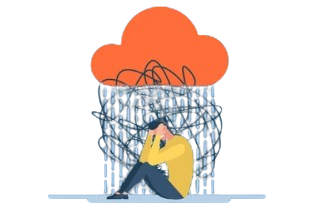
Depression & Anxiety
264 million people worldwide live with depression and anxiety. In 2017, around 17.3 million adults age 18 or older in the U.S. had experienced at least one major depressive episode in the last year (6.7% of adults in the U.S.).* (National Institute of Mental Health)
Losing a loved one, getting fired from a job, going through a divorce, and other difficult situations can lead a person to feel sad, lonely and scared. These feelings are normal reactions to life’s stressors. Most people feel low and sad at times. However, in the case of individuals who are diagnosed with depression as a psychiatric disorder, the manifestations of the low mood are much more severe, and they tend to persist.
Symptoms of depression and anxiety in women occurs more than symptoms of depression in men. Some differences in the manner in which the depressed mood manifests have been found based on sex and age. In men it manifests often as tiredness, irritability and anger. They may show more reckless behavior and abuse drugs and alcohol. They also tend to not recognize that they are depressed and fail to seek help. In women depression tends to appear as feelings of sadness, worthlessness, and guilt. In younger children it is more likely to emerge as school refusal, depression and anxiety when separated from parents, and worry about parents dying. Signs of depression in teens tend to be irritability, sadness, and difficulty behaving in school. They also frequently have co-morbid depression and anxiety, eating disorders, or substance abuse. In older adults’ depression may manifest more subtly as they tend to be less likely to admit to feelings of sadness or grief and medical illnesses which are more common in this population also contributes or causes the depression.
There are different types of depressive disorders, and while there are many similarities among them, each depressive disorder has its own unique set of symptoms.


The most commonly diagnosed types of depression is Major Depressive Disorder. In 2017, around 17.3 million aged 18 years or older in the U.S. had experienced at least one major depressive episode in the last year, which represented 6.7 percent of all American adults. Depression is the leading cause of disability in the United States among people ages 15-44.
Major depression is characterized by having at least five nine common symptoms. One of the symptoms must be either an overwhelming feeling of sadness or a loss of interest and pleasure in most usual activities. The other symptoms that are associated with major depression include decrease or increase in appetite, insomnia or hypersomnia, psychomotor agitation or retardation, constant fatigue, feelings of worthlessness or excessive and inappropriate guilt, recurrent thoughts of death and suicidal ideation with or without specific plans for committing suicide, and cognitive difficulties, such as, diminished ability to think, concentrate and take decisions. The symptoms must persist for two weeks or longer and represent a significant change from previous functioning. Social, occupational, educational, or other important functioning are impacted by major depressive disorder. For instance, the person may start missing work or school, or stop going to classes or their usual social activities.
Therapy for adults and children suffering from depression and anxiety disorders, obsessive-compulsive disorders (OCD) and depression are treated with Cognitive Behavioral Therapy (CBT), considered the “Blue Ribbon” intervention for these illnesses.
Contact us now
Depression:
If someone you know is dealing with depression, it’s important to provide emotional support, encourage them to seek professional help, be patient, and help them with daily tasks. It’s also crucial to take care of your own mental health during this time.
Dealing with depression often involves a combination of therapy, medication, lifestyle changes, and social support. Cognitive Behavioral Therapy (CBT), Interpersonal Therapy (IPT), and Mindfulness-Based Cognitive Therapy (MBCT) are common forms of therapy used Antidepressants may be prescribed by a healthcare provider. Regular exercise, a healthy diet, adequate sleep, and reducing alcohol intake can also help manage symptoms.
Depression can feel different for everyone. Common feelings include persistent sadness, emptiness, or hopelessness, loss of interest in activities once enjoyed, fatigue, difficulty concentrating or making decisions, and sometimes thoughts of death or suicide. It can also cause physical symptoms like changes in appetite or sleep habits.
Overcoming depression often requires professional help, including psychotherapy and possibly medication. Lifestyle changes like regular physical activity, a healthy diet, sufficient sleep, reducing alcohol intake, and staying connected with others can also be helpful. It’s important to reach out to healthcare providers for a proper diagnosis and treatment plan.

